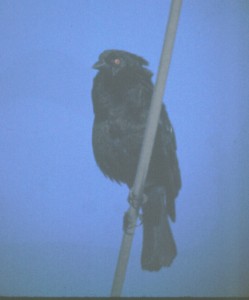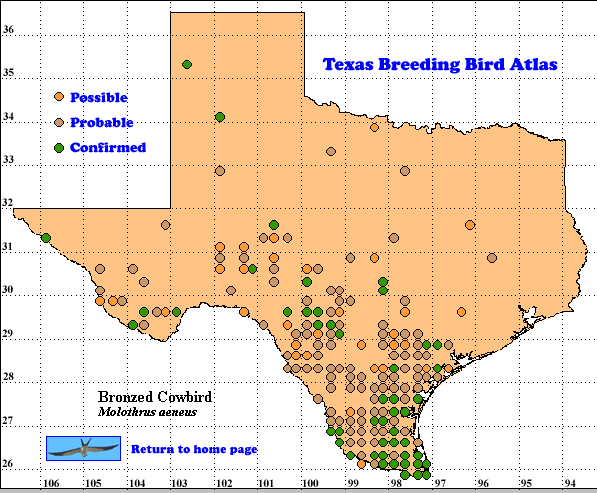The Bronzed Cowbird is one of three parasitic cowbirds that breed in the United States. Our knowledge of this species suffers from lack of study, especially compared to its much better known relative, the smaller Brown-headed Cowbird (M. ater).
The adult male Bronzed Cowbird with its hunched posture, all-black plumage and red eye was easy for TBBA atlasers in south Texas to identify. Shiny Cowbird (M. bonariensis), a new arrival in Texas since the atlas fieldwork (Amer. Ornithol. Union 1998), is smaller, and adult males have a brown eye and glossy purplish plumage. They also lack the neck ruff, which gives a Bronzed Cowbird male its hunched appearance. Separation of females and immature birds of these three species takes experience and careful observation; see Lowther (1995) and Pyle (1997) for identification details.
The nominate subspecies of Bronzed Cowbird is found in Texas and south along the east coast of Mexico. Another subspecies (M. a. loyei) is found in Arizona and northwest Mexico.
DISTRIBUTION. During the 1987-1992 field work period of the TBBA project most Texas records of this species come from south of the 32nd parallel, and between the 97th and 103rdmeridians.
Outside Texas Bronzed Cowbirds are found from southeast California, Arizona and New Mexico, south on both coasts of mainland Mexico, through Central America, to coastal Colombia.
Bronzed Cowbirds have established breeding populations in the New Orleans, LA, area, and on the west coast of Florida. Wanderers have been reported in other states also (Lowther 1995, Am. Ornithol. Union 1998).
In winter most Bronzed Cowbirds move south from the United States into Mexico, leaving a small area of year-round residents in the South Texas Brush Country and lower Rio Grande valley (Lockwood and Freeman 2004). See also maps in Howell and Webb (1995) and Lowther (1995),
SEASONAL OCCURRENCE. TBBA observers found confirmed breeding evidence from June 4 to August 22. Obtaining confirming evidence for brood parasites is not easy. The reported breeding season in Texas is mid-March to early September, egg dates: March 26 to August 9. Much of the breeding population moves south to Mexico by late September. The remaining birds gather in flocks with other blackbirds, often in fields to forage on seeds and insects stirred up by cattle (Oberholser 1974).
BREEDING HABITAT. In Texas the elevational range is sea level to 600 m (2000 ft; Oberholser 1974). Bronzed Cowbirds are found in open country, ranches, roadside thickets, open woods, parks, and orchards (Harrison 1979). Since a number of the hosts listed below often nest in dense thickets, that habitat is probably also penetrated by the Bronzed Cowbird in Texas (see accounts of host species in this atlas).
Bronzed Cowbirds generally parasitize larger hosts than Brown-headed Cowbirds do. Frequent hosts include: Orchard (Icterus spurius), Hooded (I. cucullatus), Altamira (I. gularis), Audubon’s (I. graduacauda), and Bullock’s (I. bullockii) orioles; Red-winged Blackbird (Agelaius phoeniceus); Northern
Mockingbird (Mimus polyglottos); Long-billed Thrasher (Toxostoma longirostre); Green Jay (Cyanocorax yncas); Northern Cardinal (Cardinalis cardinalis) and Olive (Arremonops rufuirgatus); and Song (Melospiza melodia; sparrows; Lowther 1995). Of 82 species reported to be parasitized by Bronzed Cowbirds, orioles appear to be favored as hosts (Friedmann 1963).
In ½ to 2/3 of host nests containing Bronzed Cowbird eggs, only 1 or 2 cowbird eggs were present, but a few nests had 6 or more cowbird eggs. The incubation period is 11 (range 10-12) days (Lowther 1995). Eggs are similar to those of Black-throated Sparrow (Amphispiza bilineata) and Blue Grosbeak (Passerina caerulea), but larger (Harrison 1979).
STATUS. Bronzed Cowbird is an abundant summer resident in south Texas (Lockwood and Freeman 2004) at the highest density in the United States. Breeding Bird Survey (BBS) observers reported averages as high as 32.8 to 75.4 Bronzed Cowbirds per 40 km (25 mi) route on 3 routes in Willacy, Inglebert, and Cameron counties. Abundance in the Big Bend area averaged 2-3 birds per route (Price et al. 1995, Sauer et al. 2004). Oberholser (1974) reported Bronzed Cowbirds to be abundant to common from Laredo, Beeville, and Corpus Christi south; common to uncommon from there north to Uvalde, San Antonio, and Rockport; and irregularly uncommon north to Austin, and Galveston. There can be considerable annual variation.
In winter Christmas Bird Counters found Bronzed Cowbird densities as high as 30-100 per 25 km (15 mi) diameter circle in South Texas Brush Country and this species was found at densities dropping to <1 bird per count circle as far north as Houston and the Edwards Plateau. (Sauer et al.1996).
Oberholser (1974) attributed an increase in Bronzed Cowbird numbers in the Rio Grande delta to changes in agriculture following a hard freeze in 1951. Cotton fields and cattle feedlots, excellent winter habitat for cowbirds and other blackbirds replaced dead citrus trees.
In Texas for 1966-2003, BBS data show a 95% confidence interval of -3.0 to 4.5% population change per year (there is a 95% chance the actual trend value will fall between these two figures) for the 49 routes in the state on which this species was detected (Sauer et al. 2004).
This trend data is encouraging, suggesting expansion of the breeding population of this brood parasite has slowed since the period before the start of the BBS Text by Robert C. Tweit. (2005)
Literature cited:
American Ornithologists’ Union. 1998. Checklist of North American Birds, 7th edition. American Ornithologists’ Union, Washington, DC.
Friedmann, H. 1963. Host relations of the parasitic cowbirds, U.S. Natl. Mus. Bull. 233.
Harrison, H. H. 1979. A field guide to western birds’ nests. Houghton Mifflin, Boston, MA.
Howell, S. N. G., and S. Webb. 1995. A guide to the birds of Mexico and northern Central America. Oxford University Press, New York.
Lockwood, M. W. and B. Freeman. 2004. The TOS handbook of Texas birds. Texas A&M University Press, College Station.
Lowther, P. E. 1995. Bronzed Cowbird (Molothrus aeneus). In The birds of North America, No. 144 (A. Poole and F. Gill, eds.). The Birds of North America, Inc., Philadelphia, PA.
Oberholser, H. C. 1974. The bird life of Texas, Vol. 2. University of Texas Press, Austin.
Price, J., S. Droege, and A. Price. 1995. The summer atlas of North American birds. Academic Press, New York.
Pyle, P. 1997. Identification Guide to North American birds, Part 1. Slate Creek Press, Bolinas, CA.
Sauer, J. R., S. Schwartz, and B. Hoover. 1996. The Christmas Bird Count Home Page, Version 95.1. Patuxent Wildlife Research Center, Laurel MD (Web site, http://www.mbr-pwrc.usgs.gov/bbs/cbc).
Sauer, J. R., J. E. Hines, and J. Fallon. 2004. The North American Breeding Bird Survey, results and analysis 1966-2003. Version 2004.1. USGS Patuxent Wildlife Research Center, Laurel MD (Web site, http://www.mbr-pwrc.usgs.gov/bbs).

